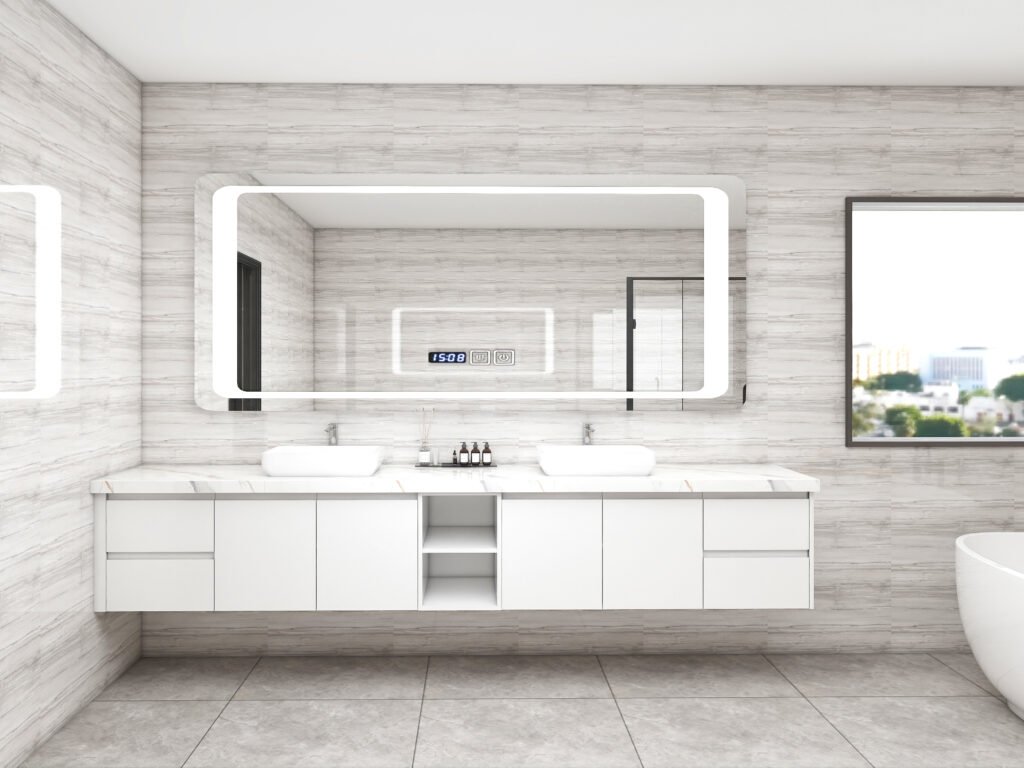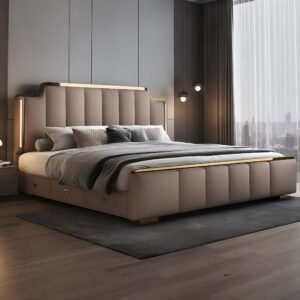Bathroom cabinets are an essential component of any bathroom, both practical and beautiful. Bathroom cabinets come in a variety of styles, materials, and configurations, so it is important to understand the style you want before renovating and designing your bathroom. Today, the designers of Cs Home will take you through all the information about bathroom cabinets, from types and materials to installation and maintenance.
Types of Bathroom Cabinets
Bathroom cabinets can be categorized into several types based on their design and placement:
- Vanity Cabinets: These are the most common type of bathroom cabinets, typically placed under the sink. They provide storage space for toiletries, cleaning supplies, and other essentials. Vanity cabinets come in various styles, including freestanding, wall-mounted, and corner vanities
- Wall Cabinets: Mounted on the wall, these cabinets are perfect for adding extra storage without taking up floor space. They are ideal for small bathrooms and come in different heights and widths to suit various needs.
- Medicine Cabinets: These cabinets are usually placed above the sink or vanity and have a mirrored front. They are designed to store medicines, first aid supplies, and other small items.
- Linen Cabinets: Tall and narrow, linen cabinets are designed to store towels, linens, and other bathroom textiles. They can be freestanding or wall-mounted and often feature multiple shelves and compartments.
- Over-the-Toilet Cabinets: These cabinets make use of the space above the toilet, providing additional storage without occupying floor space. They are ideal for small bathrooms where every inch of space matters.
Materials for Bathroom Cabinets
Choosing the right material for your bathroom cabinets is essential for durability and aesthetics. Here are some popular materials used for bathroom cabinets:
- Wood: Solid wood cabinets are classic and durable, offering a warm and natural look. Common wood types include oak, maple, and cherry. However, wood cabinets require proper sealing to protect against moisture and humidity.
- MDF (Medium-Density Fiberboard): MDF is a budget-friendly alternative to solid wood. It is made from wood fibers and resin, providing a smooth and uniform surface. MDF cabinets are often coated with a veneer or laminate for added protection.
- Plywood: Plywood cabinets are made from multiple layers of wood veneer, making them strong and stable. They are more resistant to warping and moisture compared to solid wood.
- Laminate: Laminate cabinets are made from a thin layer of plastic or paper fused to a substrate like MDF or particleboard. They are available in a wide range of colors and patterns, offering a versatile and cost-effective option.
- Metal: Metal cabinets, usually made from stainless steel or aluminum, offer a sleek and modern look. They are highly durable and resistant to moisture, making them ideal for bathrooms.
- Glass: Glass cabinets add a touch of elegance and sophistication to any bathroom. They can be used for cabinet doors or shelves, providing a visually appealing storage solution.
Installation of Bathroom Cabinets
Installing bathroom cabinets can be a DIY project or done by a professional. Here are the basic steps for installing bathroom cabinets:
- Planning: Measure your bathroom space and decide on the type and size of cabinets you need. Consider the layout and placement to ensure optimal functionality.
- Preparation: Remove any existing cabinets or fixtures. Ensure the walls and floor are clean and level.
- Installation: Follow the manufacturer’s instructions for assembling and installing the cabinets. Use a level to ensure the cabinets are straight and secure them to the wall studs with screws.
- Finishing Touches: Install any additional features such as handles, knobs, or shelves. Ensure all doors and drawers open and close smoothly.
Maintenance of Bathroom Cabinets
Proper maintenance is key to extending the life of your bathroom cabinets. Here are some tips to keep your cabinets in top condition:
- Cleaning: Regularly clean the cabinets with a mild soap and water solution. Avoid using harsh chemicals or abrasive cleaners that can damage the finish.
- Sealing: If you have wood cabinets, ensure they are properly sealed to protect against moisture. Reapply sealant as needed to maintain the finish.
- Repairing: Address any issues such as loose hinges, broken handles, or scratches promptly. Regularly check for signs of wear and tear and make necessary repairs.
- Ventilation: Ensure your bathroom is well-ventilated to prevent moisture buildup, which can lead to mold and mildew. Use exhaust fans or open windows to promote air circulation.
Design Considerations for Bathroom Cabinets
When choosing bathroom cabinets, consider both functionality and aesthetics. Here are some design considerations to keep in mind:
- Style: Choose a style that complements your bathroom’s overall design. Popular styles include modern, traditional, rustic, and minimalist.
- Color and Finish: Select a color and finish that enhances the look of your bathroom. Neutral colors like white, gray, and beige are versatile and timeless, while bold colors can make a statement.
- Hardware: The hardware, such as handles and knobs, can add a finishing touch to your cabinets. Choose hardware that matches the style of your cabinets and bathroom décor.
- Storage Needs: Consider your storage needs and choose cabinets with the right combination of shelves, drawers, and compartments to keep everything organized.
- Space: Make sure the cabinets fit well within your bathroom space without overcrowding. Measure the available space and choose cabinets that offer ample storage while allowing for easy movement.
Conclusion
In conclusion, understanding bathroom cabinets involves considering various factors such as types, materials, installation, maintenance, and design. By choosing the right cabinets for your bathroom, you can enhance both functionality and aesthetics, creating a space that is organized, stylish, and durable. Whether you are remodeling or installing new cabinets, this complete guide provides the essential information to make an informed decision. Remember to assess your needs, explore different options, and maintain your cabinets properly to enjoy their benefits for years to come.
FAQs
Q1. What are the different types of bathroom cabinets?
A1:
Bathroom cabinets include vanity cabinets, wall cabinets, medicine cabinets, linen cabinets, and over-the-toilet cabinets, each serving different storage needs and fitting various spaces.
Q2. What materials are commonly used for bathroom cabinets?
A2:
Popular materials for bathroom cabinets are wood, MDF (Medium-Density Fiberboard), plywood, laminate, metal, and glass, chosen based on factors like durability, appearance, and resistance to moisture.
Q3. How do you install bathroom cabinets?
A3:
Installation involves planning, preparation, assembling, securing cabinets to wall studs, and adding finishing touches like handles and knobs. It’s important to follow manufacturer instructions for best results.
Q4. What maintenance is required for bathroom cabinets?
A4:
Regular cleaning with mild soap and water, sealing wood cabinets, promptly repairing any issues, and ensuring good bathroom ventilation are key maintenance practices.
Q5. How to choose suitable cabinets for a small bathroom?
A5:
For small bathrooms, opt for compact vanity cabinets, wall cabinets, or over-the-toilet cabinets that efficiently utilize limited space while providing ample storage.




